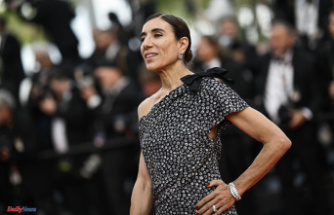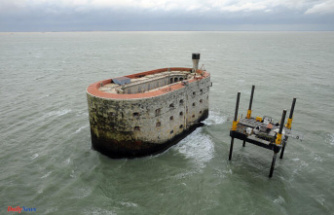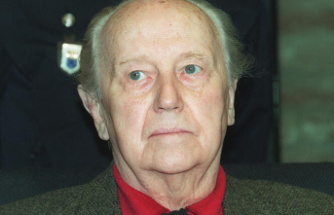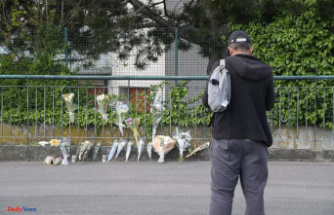Even before the deep double bass E-flat, with which everything begins, the image has placed itself before the music in the Bayreuth Festspielhaus. Water ripples slightly on the canvas. The original element not only of this tetralogy is transformed into an amniotic sac. Cello movements and first wind figures accompany an ascending double helix, which turns out to be twin umbilical cords. Even in the womb there is already fighting, survival has already begun.
Is that Siegmund and Sieglinde, for whom we still have to wait an opera? Or Siegfried and Hagen? Or the light and after albums Wotan and Alberich, after all one kicks the other between the legs and the other puts his finger in the other person's eye?
The virtual embryos in the film, like everyone else involved in the new “Ring des Nibelungen” on the Green Hill, had to wait 730 days for this moment. The premiere should be in July 2020, Corona delayed it. When the curtain rises, Alberich, a disheveled dropout in black jeans, clearly keeps his step. Olafur Sigurdarson does it quite outlaw-like, sings pithy and quickly becomes the focus of the following, very entertaining two hours and twenty minutes.
Alberich stumbles out of a shallow pool somewhere in a hot semi-desert area. Anyone who now associates “Breaking Bad” and New Mexico instead of Worms, Speyer and Germania in the Rhineland might not be wrong at all. The 33-year-old director Valentin Schwarz promised a very up-to-date and yet timeless series view and dramaturgy for his "Ring", Wagner as a sounding live streaming event.
And so the prelude now unfolds as a sort of pilot episode of the mini four-part series that introduces the characters in their seventies-chic multi-generational house, just as Andrea Cozzi designed it very stylishly, but also minimalistically with lots of open transformations. First of all, the Rhine has become an artificial bathing area, as with the Bayreuth "Ring" predecessor Frank Castorf, a little more elegant than its shabby gas station motel with a plastic pool on Route 66, laid out with black marble.
In it, the Rhinemaidens (solid trio: Lea-ann Dunbar, Stephanie Houzzel, Katie Stevenson) cavort lasciviously as nannies with aprons, money seems to be there in this clan. In the back, the youngsters are having fun, only one boy in a yellow T-shirt and a baseball cap sits there in isolation, stroking a pump-action water gun.
The gold, the hoard, that's obviously this brood, and Alberich grabs the outsider and kidnaps him. The musical motive clearly reveals it: the boy becomes the cursed ring, possibly also the Alberich son Hagen? That will probably only become clear - cliffhanger! - can be clearly decrypted in episode four.
While from the Graben, where the Stuttgart general music director Cornelius Meister, who stepped in for the covid-ill Pietari Inkinen, manages the sound, still a little reluctantly, yes even quietly, despite the tempo trotting ahead, the story succeeds lightly and fluently, Valentin Schwarz lays on the stage his narrative threads. Above all, he introduces a few more participants before the time Wagner intended.
The Valkyries, for example, Wotan's nine daughters with Erda, who is also present in the living room alongside Fricka. Erda, the first woman (Christa Mayer sings her lovingly, accusingly, nastily) as an overstyled matron, Fricke, the second (the wonderful, clear-toned, yet full-bodied Okka von der Damerau) seems to be the housekeeper. Erda stands there, observes, snorts contemptuously, finally bangs a tray with decanters on the floor when she finally vocally demonstrates his omissions and crimes to Wotan. And in the end sneaks away with a suitcase and a probably already traumatized Brünnhilde.
Their eight sisters who are locked away are obviously the Nibelungen in Alberich's rainbow kindergarten glass case, cloned horror film kids in pink dresses with plaits painting old-fashioned Wotan pictures with a winged helmet. They are cared for by the other Alberich brother, Mime, to whom Arnold Bezuyen bestows a promising tenor abyss. The clattering of the anvil, kept very loud and short, is probably intended to symbolize the collective gathering of food.
In between, Hagen (let's just say) is on the move as an aggro turbo, tormenting his cousins, smearing windows and walls. This unbridled temperament, which of course no one really cares about, clearly points in the negative direction. He is later sedated with a Rubix cube in a kind of children's room on the first floor by his uncle Wotan, who took him away from Alberich by force: this will not end well.
But this whole family, framed by serving spirits, as it spreads between Eames chair, gray slats, terrarium with snake, tropical wood paneling and bookshelf (there are even conversation encyclopedias!) with Old Master paintings, may be very new rich, but it is up to the core rots. What Andy Visit embellishes and camouflages with his sophisticated costumes.
It all started with Wotan, a vain patriarch who only wore short tennis pants and a medal around his neck as an old Bumbum-Boris, later a beige suit. Egils Silins, one of the Wotane who stepped in, casually plays him as an oligarch creep with a somewhat scratched parlando voice and pistol instead of spear. In this banal bagage between mafia and Geissens reality, all of them are somehow addicted to addiction, right down to the subgods.
The frightened Freia (Elisabeth Teige) draws one line after the other behind her green, life-extending apples in a glitter caftan. Froh (Atilio Glaser) in frog green drinks the bar car empty. And the Prussian blue thunder (emphatically: Raimund Nolte) drives away the storm clouds for the only slightly weather-illuminated rainbow bridge to Valhalla very merrily by shooting an apple with Dad's golf club from the whiskey tumbler, which causes back pain.
Valentin Schwarz explains the backstory very clearly – for example through the video gallery on the mobile phone of the elderly queer spin doctor Loge (perfect shape down to the greasy hair: Daniel Kirch) – but also lays out various loose leads. Not all direct reinterpretations work. The criminal businessmen giants (Jen-Erik Asbø as the sensitive Fasolt and Wilhelm Schinghammer as the brutal Fafner) remain marginal figures in their black SUV. Piling up gold as a Valhalla construction fee turns out to be problematic for them due to the lack of precious metal. The transformations using a magic cloak, with which the mini Hagen assists, remain silly.
It's cheeky how Valentin Schwarz refuses common theater tricks like the rainbow bridge. Here only a Wagner record is played for the last bars, Wotan dances silly along to it, no sad god just a gloomy gangster boss. The mob has moved into the "ring". Radical today, still told very directly, with an extremely low drop. Not all viewers like that. There was booing, but the enthusiastic crowd clearly outnumbered them.
It's definitely entertaining so far. Also because Cornelius Meister in the second half of "Rheingold" brings the orchestra more to full blossoming, to spraying colors, to more presence altogether. His Bayreuth "Ring", in Stuttgart he is just halfway through "Ring", is appropriately myth-free, a cheerful soundscape with sinister undertones. But that should increase. The vocals can also be increased vocally. The binge-watching in Wagner's name can continue uninterrupted here, because the hopefully richer and more emotional "Valkyrie" will follow in Bayreuth immediately.












